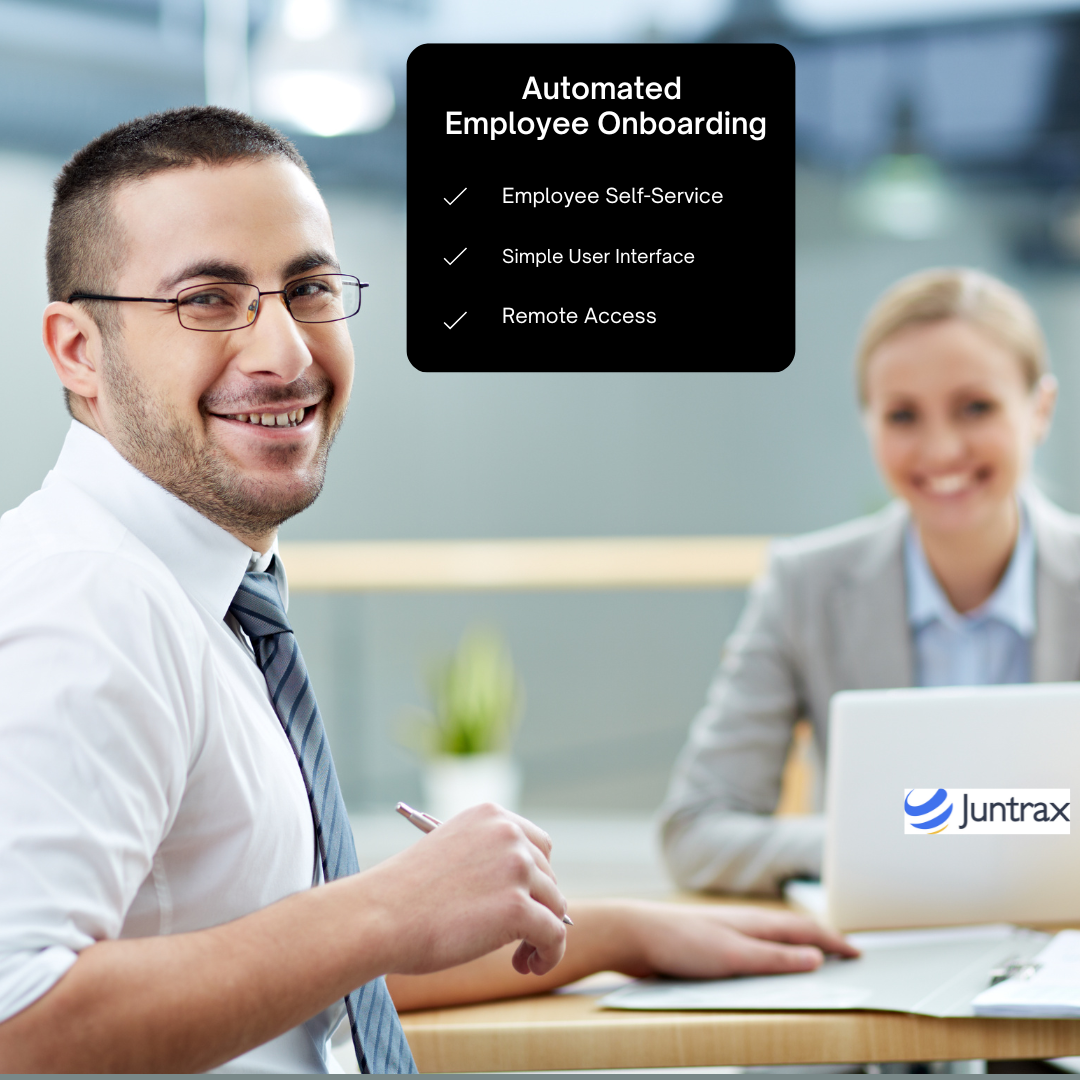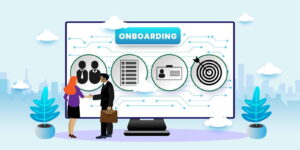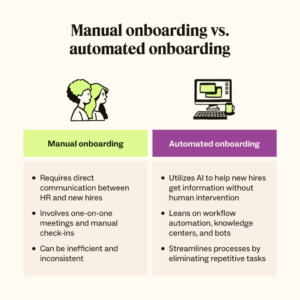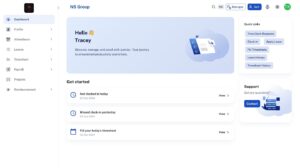Is Automated On-boarding a Boon or Bane?


In today’s fast-paced business environment, efficiency and productivity are more crucial than ever. Companies are constantly seeking innovative solutions to streamline their processes, and one area that has seen significant advancement is employee onboarding.
Automated onboarding technologies promise to transform how new hires integrate into the workplace, offering speed, consistency, and reduced administrative burden.
In fact, over two-thirds of organizations have incorporated AI into their onboarding processes. This integration allows for a more tailored and engaging experience, optimizing efficiency and improving retention rates.
However, while the benefits seem clear, there are valid concerns about the potential downsides.
Could automated onboarding lead to a lack of personal touch and decreased employee engagement?
In this article, we delve into the pros and cons of automated onboarding systems, exploring whether they truly enhance the onboarding experience or if they introduce new challenges that businesses must address.
What is Digital Employee Onboarding?

Digital employee onboarding is an innovative and modern approach to integrating new hires into a company using technology-driven solutions.
Unlike traditional onboarding, which often involves face-to-face meetings, manual paperwork, and bit-by-bit training sessions, automated onboarding utilizes various online tools and platforms to deliver a seamless, efficient, and comprehensive onboarding experience.
At its core, digital onboarding typically involves using software applications to automate various tasks.
These tasks can range from filling out essential forms and setting up direct deposits to completing compliance training and accessing key company resources.
The goal is to streamline these processes to minimize the administrative load on HR departments while ensuring new employees have everything they need from day one.
Components of Automated Onboarding
Let’s break down some components of digital employee onboarding:
- Automated Paperwork: One of the most laborious parts of onboarding is handling the paperwork. Digital onboarding platforms automate this by allowing employees to complete and submit all necessary forms online. Tax documents, contracts, and personal information forms can be filled out and signed electronically, saving time and reducing errors.
- Online Training Modules: Orientation and training are critical to helping new hires understand their roles and the company culture. Digital platforms provide interactive, engaging, and standardized training modules that employees can complete independently. These modules often include videos, quizzes, and informational content customized to various organizational roles.
- Centralized Information Access: A digital onboarding system typically includes a centralized portal where new hires can access all relevant company information, policies, and resources. This might include employee handbooks, procedural guides, organizational charts, and contact lists. Easy access ensures new employees always have the information they need at their fingertips.
- Task Management and Monitoring: Digital onboarding platforms often feature task management tools that help both HR personnel and new hires keep track of required steps in the onboarding process. Automated reminders and progress tracking ensure nothing falls through the cracks, contributing to a smoother onboarding experience.
- Virtual Introductions and Mentoring: Digital onboarding tools can facilitate virtual introductions and mentorship programs. Platforms may include features like chat functions, video calls, and collaborative workspaces that allow new employees to connect with colleagues and mentors, fostering relationships even before physically meeting.
- Feedback and Customization: Many digital onboarding systems include mechanisms for collecting feedback from new hires on their onboarding experience. This feedback can be invaluable in customizing and improving the process for future employees. Customizable solutions also allow HR teams to adapt onboarding workflows to specific departmental needs or roles within the company.
Benefits of Automated Onboarding
Automated onboarding has rapidly gained traction in the corporate world, and for good reason. As companies strive to enhance efficiency and improve the new hire experience, automated onboarding systems offer a plethora of benefits that can make a significant difference. Let’s dive deeper into the main advantages of automated onboarding:
-
Streamlined Processes and Time Savings:
One of the most evident benefits of automated onboarding is the sheer efficiency it brings to the table. By automating routine tasks such as form submission, ID verification, and document management, HR departments can significantly reduce the time spent on administrative duties. This allows HR professionals to focus on more strategic initiatives, thus propelling the organization forward. -
Consistency and Standardization:
With automated systems, companies can ensure every new employee goes through a consistent and standardized onboarding process. This uniformity helps guarantee that all new hires receive the same quality of orientation and training, regardless of their department or location. Consistency is key to maintaining compliance with company policies and legal requirements, thereby reducing the risk of errors. -
Enhanced Employee Experience:
 First impressions matter, and an efficient, well-organized onboarding process can set a positive tone for a new hire’s journey within the company. Automated onboarding systems often include user-friendly interfaces and interactive elements that make the experience more engaging and less overwhelming. This can lead to higher satisfaction levels, better acclimatization, and faster productivity.
First impressions matter, and an efficient, well-organized onboarding process can set a positive tone for a new hire’s journey within the company. Automated onboarding systems often include user-friendly interfaces and interactive elements that make the experience more engaging and less overwhelming. This can lead to higher satisfaction levels, better acclimatization, and faster productivity. -
Reduced Paperwork and Environmental Impact:
Moving from paper-based processes to digital onboarding significantly cuts down on paper usage, promoting a greener, more sustainable practice. Beyond environmental benefits, digital records are easier to store, search, and retrieve, minimizing the risks associated with physical document management such as loss, damage, or unauthorized access. -
Improved Compliance and Security:
Automated onboarding platforms are designed to adhere to regulatory and compliance standards, ensuring that sensitive information is handled correctly. Features such as secure data storage, encryption, and permission-based access help protect personal data, minimizing the risk of breaches. Additionally, automated systems often include compliance checklists to ensure all necessary legal and regulatory steps are completed accurately. -
Better Analytics and Reporting:
One of the standout features of automated systems is the ability to capture and analyze vast amounts of data seamlessly. HR teams can easily track the progress of new hires, monitor completion rates for onboarding tasks, and gather valuable insights through real-time reporting tools. This data can be instrumental in refining the onboarding process, identifying bottlenecks, and implementing data-driven improvements. -
Seamless Integration with Other Systems:
Many automated onboarding solutions are designed to integrate with existing HR, payroll, and talent management systems. This interoperability ensures a smooth flow of information across different platforms, reducing redundancy and enhancing the overall efficiency of HR operations. Integration ensures that new hire data is accurately and quickly reflected across all relevant systems. -
Scalability for Future Growth:
As companies grow, the scalability of automated onboarding systems becomes particularly advantageous. Whether a company is onboarding a few employees or hundreds, automated platforms can handle fluctuations in hiring volume without compromising on quality or efficiency. This flexibility is essential for organizations experiencing rapid growth or seasonal hiring spikes.
Shortcomings of Automated Onboarding
While automated onboarding offers many advantages, it’s essential to acknowledge that no system is without its drawbacks. Understanding the potential shortcomings of automated onboarding can help companies address these issues proactively, ensuring a more balanced approach. Here’s a detailed exploration of the potential pitfalls:
-
Lack of Personal Touch:
Automated onboarding can sometimes feel impersonal and detached. While it excels in efficiency and consistency, it may lack the human touch that can make new employees feel genuinely welcomed and valued. Personal interactions, such as face-to-face meetings or personalized welcome messages, can be challenging to replicate in a fully automated system. -
Technical Challenges and Dependence:
The reliability of an automated onboarding system hinges on its technical robustness. Technical glitches, system downtimes, or software bugs can disrupt the onboarding process, leading to frustration for both new hires and HR teams. Additionally, companies become heavily dependent on their IT infrastructure and vendor support, which can be risky if issues arise. -
Complexity and Learning Curve:
Implementing an automated onboarding system can be complex and may require substantial time and resources to set up. There is often a learning curve for both HR professionals and new employees, who must become familiar with the new platform. Training and ongoing support are crucial to ensuring smooth transitions but can also add to the initial burden. -
Limited Customization:
While many automated onboarding systems offer some degree of customization, they may not always meet every company’s unique needs. Organizations with very specific onboarding requirements or unique processes might find it challenging to mold the software to fit seamlessly. This lack of flexibility can sometimes lead to a compromise between standardization and tailored experiences. -
Security and Privacy Concerns:
Automated onboarding systems handle vast amounts of sensitive personal data, which can be a prime target for cyber-attacks. Despite built-in security features, there is always a risk of data breaches or unauthorized access. Companies must invest in robust security measures and ensure compliance with data protection regulations to mitigate these risks. -
Potential for Reduced Engagement:
Automated processes might inadvertently lead to reduced engagement levels. New hires might feel isolated or less connected to their colleagues and company culture without interactive, face-to-face communication. Balancing automation with human elements is essential to foster a sense of belonging and community among new employees. -
High Initial Investment:
Implementing an automated onboarding system requires a significant upfront investment in software, training, and integration with existing systems. Despite the long-term benefits, the cost can be a considerable barrier for small to medium-sized businesses. Careful cost-benefit analysis and planning are necessary to justify the expenditure. -
Risk of Over-reliance on Automation:
Relying too heavily on automated systems can lead to complacency. Companies might neglect the importance of continuous improvement and human oversight. Additionally, Regular reviews and updates are essential to keeping the onboarding process relevant and effective, ensuring that automation enhances rather than replaces human judgment.
Balancing Automation with Personalization
While automation streamlines tasks, consistency, and speed, infusing personalization ensures new hires feel valued, connected, and adequately prepared. Understanding this balance is key to a successful onboarding experience.
-
Combining Efficiency with Human Connection:
Automation excels in managing routine tasks such as paperwork, training modules, and compliance tracking, freeing up HR professionals to focus on more personal interactions. However, effective onboarding retains the essence of human connection. Scheduling personal welcome calls, mentor introductions, or team integration meetings can imbue the process with warmth and trust. -
Tailoring Content to Individual Needs:
Automation can deliver personalized content based on specific roles, departments, or individual preferences. By setting up profiles that capture a new hire’s background, interests, and learning style, companies can tailor training materials, resources, and communication to resonate more personally. This approach fosters a more engaging and relevant onboarding experience. -
Interactive Platforms and Tools:
Utilizing interactive tools within automated systems can bridge the gap between technology and human touch. Incorporating elements such as virtual reality tours, interactive quizzes, and video messages from leadership can make the process more dynamic and engaging. These tools can simulate real-life interaction and provide a personalized feel within a digital framework. -
Periodic Personal Check-ins:
Automation doesn’t have to mean a complete absence of personal touch. Regularly scheduled check-ins by managers or HR representatives foster a sense of support and address any concerns or questions the new employee might have. These interactions can make new hires feel seen and heard, canceling out the impersonal nature of automated processes. -
Feedback Mechanisms:
Implementing feedback loops within the automated system ensures that the onboarding experience continuously evolves. Inviting new hires to share their experiences through surveys or direct feedback sessions allows the organization to adapt and tailor the process to better meet individual and collective needs. -
Balancing Automation Levels:
It’s essential to evaluate and adjust the level of automation involved. Highly interactive roles or client-facing may require more personalized onboarding approaches, while technical or process-oriented positions might benefit more from automated modules. Customizing the balance based on the role’s nature ensures the onboarding is appropriately tailored. -
Cultural Integration:
Introducing new hires to the company culture is a critical aspect often best conveyed through personal experiences. While automated systems can share information about mission statements and workplace values, experiencing the culture firsthand through team-building activities, informal gatherings, or shadowing programs can solidify cultural understanding and integration, offering a personalized touch that automation lacks. -
Learning Pathways:
Crafting personalized learning pathways within an automated onboarding system can cater to different learning speeds and styles. The system can provide a customized learning journey by assessing the new hire’s knowledge and skill levels, blending automated learning modules with mentorship or peer-assisted learning for a holistic approach.
Bottom Line
Automated techniques will undoubtedly have a positive impact and take HR relationships to the next level. HR does what people do best—think and be creative, promote social and communication skills, and ultimately build a better work environment.
Freeing up more time for creative thinking and strategy formation is what automation facilitates.
Automation is a blessing for companies as more and more organizations embrace technology to simplify their operations and build better work dynamics in the future. Business prospects seem promising, with organizations turning to automation firmly, bringing a new era of technological advancement to an already competitive market.
When combined with automation, jobs like onboarding create a high-quality and robust work atmosphere.
With the simplicity and resources of automated onboarding, do you think it is a blessing? We believe so!
You can also read our full guide on onboarding digital employees to successfully onboard your new employees.